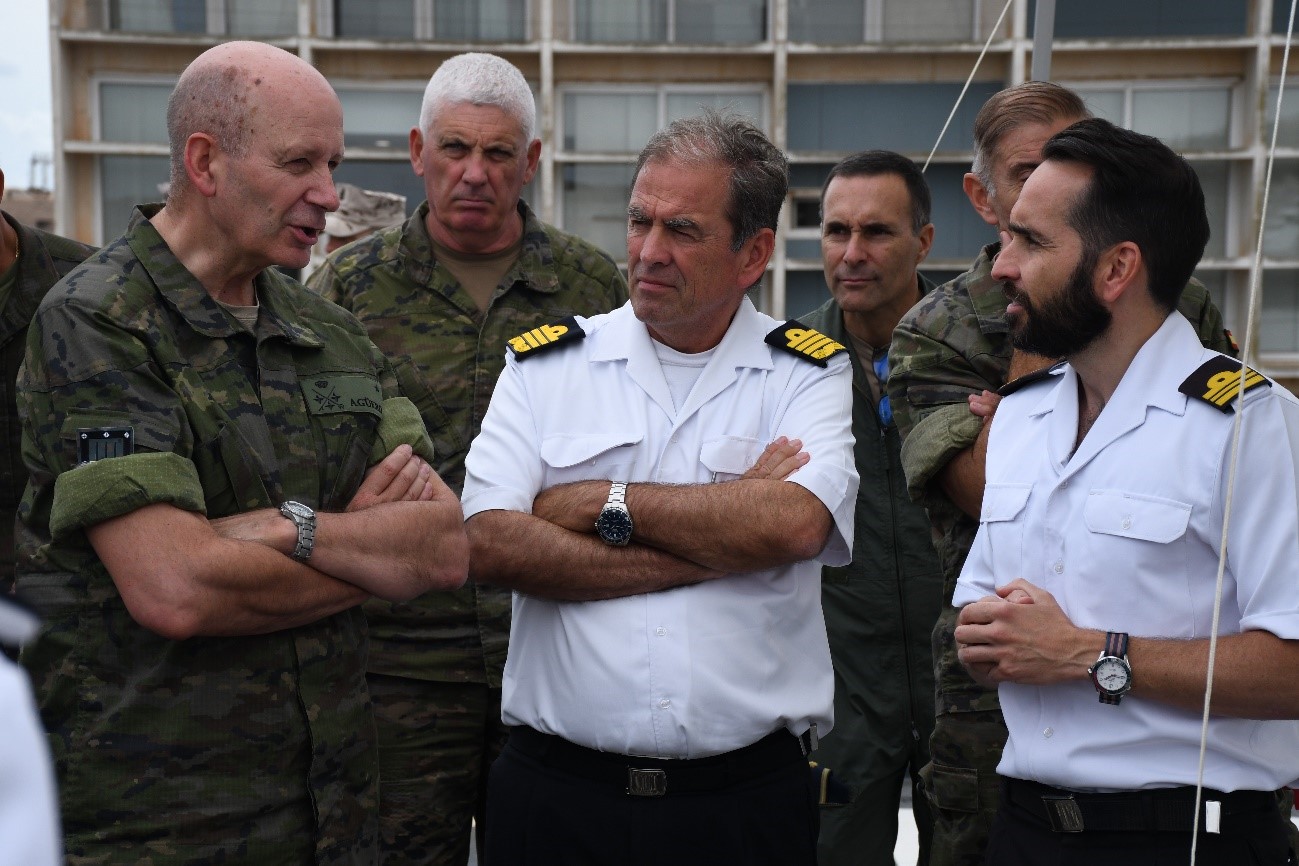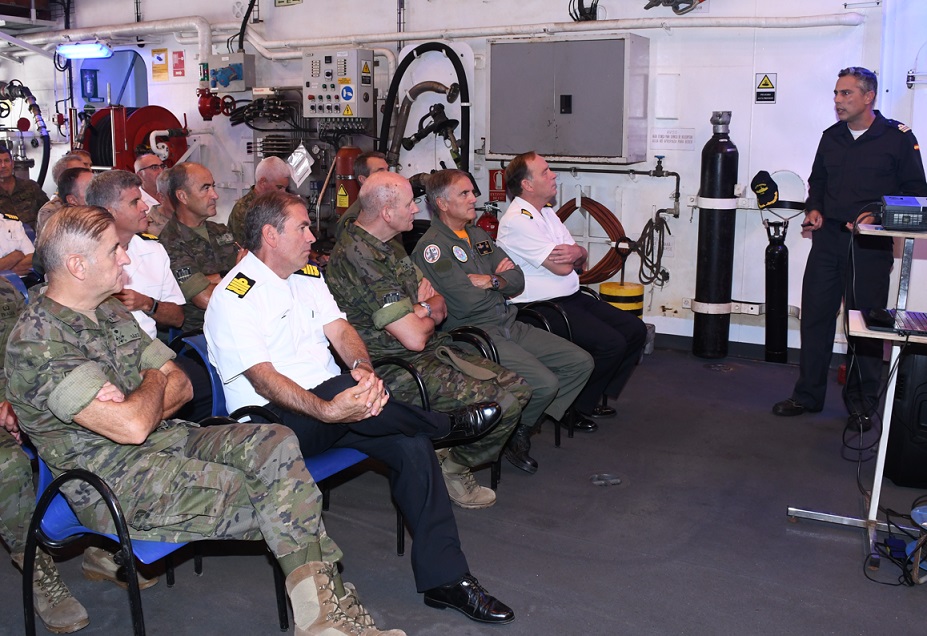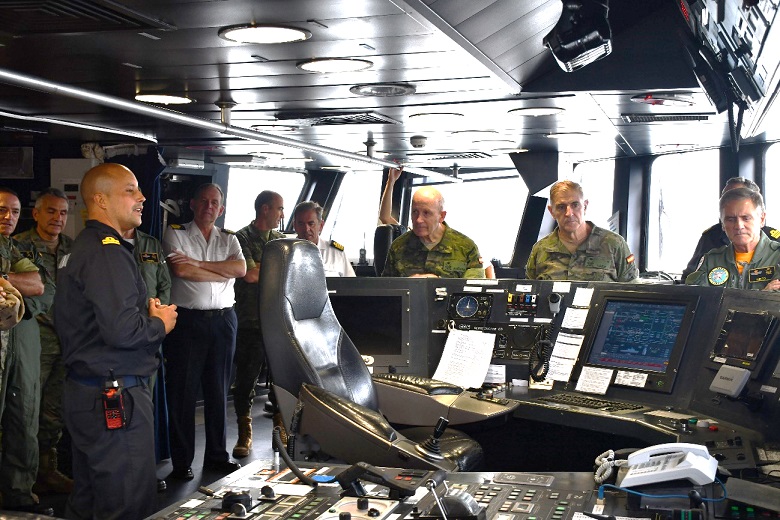
Meeting of the Operational Commands and Components of the operational structure of the SAF at the Headquarters of the Maritime Operations Force in Cartagena
- Under the chairmanship of the Join Operations Commander, the Operational Commanders and Component Commanders discuss Presence, Surveillance and Deterrence Operations.
On the morning of 19 September, the Commander of the Joint Operations Command (CMOPS) chaired the meeting of the Board of Commanders of the Operational Commands and Component Commands (JCB) at the Maritime Operations Command (MOM) Headquarters in Cartagena.
This meeting focused on analysing and evaluating Presence, Surveillance and Deterrence Operations, which are carried out under the operational control of the Joint Operations Command (MOPS). More specifically, ongoing operations to guarantee the security of sovereign spaces were reviewed, in addition to analysing and assessing current strategic priorities. As the CMOPS, Lieutenant General José Antonio Agüero Martínez, pointed out, ‘this meeting allows us to know each other even better and thus generate more trust, which is essential to overcome obstacles in the interests of greater efficiency in our operations’.
The MOPS plans and coordinates the military operations of the different Operational Commands: the Land Operational Command (MOT), the Maritime Operational Command (MOM), the Air Operational Command (MOA), the Aerospace Operational Command (MOESPA) and the Cyberspace Operational Command (MOC). These commands are responsible for permanent surveillance, thus guaranteeing the protection of Spain's interests. On a monthly basis, this forum brings together the different commands to evaluate the results of operations, coordinate actions and plan the future activity of the assigned forces.
At the Headquarters of the Maritime Operations Force (CG FAM), the general officers attending the JCB were received by the Admiral of the Navy Fleet (ALFLOT), Admiral Eugenio Díaz del Río Jáudenes, and by the Commander of the Maritime Operational Command (CMOM) and Admiral of the Maritime Operations (ALMART), Vice Admiral Victoriano Gilabert Agote.
After the JCB meeting, the attendees visited the Maritime Operations and Surveillance Centre (COVAM), which carries out permanent surveillance in waters of sovereignty and national interest to contribute to maritime security through units at sea and air assets. It also supports the work of the State Security Forces and Corps (FCSE) in the fight against illicit trafficking at sea and collaborates with NATO allies to jointly increase maritime security.
The meeting then moved to the 'Curra' dock to visit the Maritime Action Ship (BAM) ‘Relámpago’, which was in Cartagena undergoing operational qualification at the Cartagena Evaluation Centre (CEVACO-EVACART). The BAM commander highlighted the ship's operational capabilities, showing its sensors, armament, and command and control systems first-hand.
Finally, everyone watched a demonstration of underwater vehicles organised by the Navy Diving Centre (CBA), where they also saw the capabilities of underwater drones and remotely operated vehicles (ROVs), which are used in reconnaissance, explosive deactivation and seabed exploration missions. They were also able to observe how these vehicles operate in complex situations, such as the inspection of underwater infrastructures or rescue missions, and their value in security and defence operations in the marine environment.
Vice Admiral Victoriano Gilabert Agote, CMOM, highlighted the importance of hosting this Board of Commanders: ‘Cartagena is one of the main naval bases in Spain. It is home to numerous Navy units that contribute to the operational structure of the Armed Forces. Its location in the Mediterranean makes it a key point for maritime security in waters of interest to Spain. Hosting high-level meetings reaffirms Cartagena's relevance in the field of national security and defence’.
This meeting strengthens the city's relationship with the Armed Forces, which have historically been an economic and social driving force for Cartagena.
Fotos




